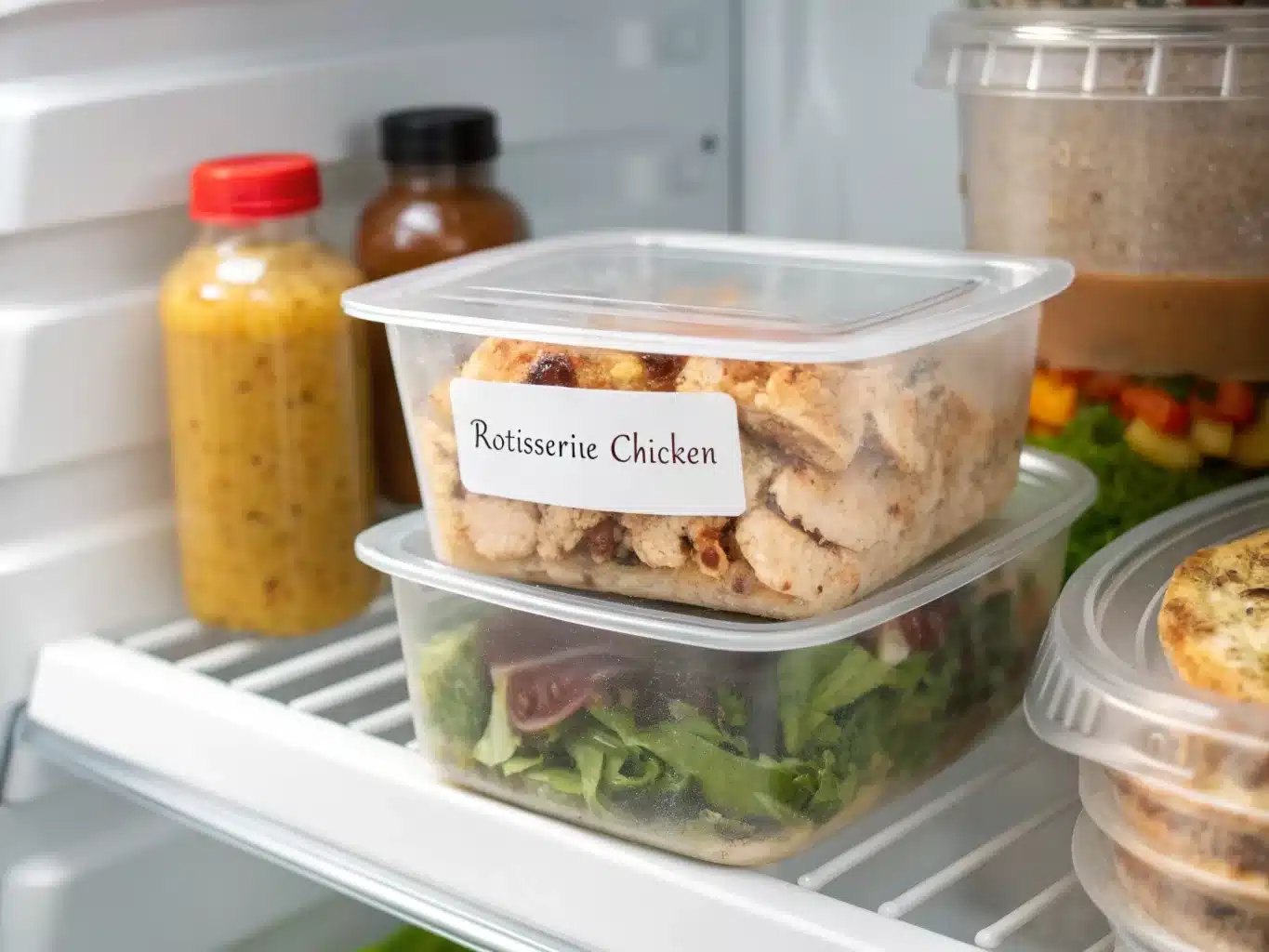A Complete Guide
Picture this: you’re standing in your kitchen, staring at the remains of a delicious rotisserie chicken from tonight’s dinner. The meat is still warm, and you’re wondering how best to store it and, more importantly, how long it will stay safe to eat. You’re not alone this is a common scenario in households across America, where rotisserie chickens have become a convenient and beloved mealtime solution.
Since the 1990s, rotisserie chickens have evolved from a simple convenience item to a cornerstone of American food culture. Retailers sell millions of these ready-to-eat birds annually, with warehouse clubs and grocery stores often using them as loss leaders to draw customers. Their popularity isn’t just about convenience; these perfectly seasoned, slow-roasted chickens often cost less than buying and cooking a raw chicken at home.
However, with this convenience comes responsibility. Proper storage of leftover rotisserie chicken isn’t just about maintaining its delicious taste it’s about ensuring the safety of you and your family. Improper storage can lead to foodborne illness, while optimal storage practices can extend the life of your leftovers and protect your health.
In this comprehensive guide, we’ll explore everything you need to know about storing leftover rotisserie chicken, from basic food safety principles to specific timeline guidelines and best practices for maximizing freshness.
Table of Contents
II. Understanding Food Safety Basics
Before diving into specific storage guidelines, it’s crucial to understand the fundamental principles of food safety that make these guidelines necessary. At the heart of food safety is the concept of the “temperature danger zone” – the range between 40°F and 140°F (4°C to 60°C) where bacteria thrive and multiply rapidly.
When it comes to cooked poultry like rotisserie chicken, bacterial growth is a particular concern. Bacteria such as Salmonella, Campylobacter, and Clostridium perfringens can multiply quickly when chicken is kept at room temperature. In fact, these bacteria can double in number in as little as 20 minutes when in the danger zone.
Refrigeration is your primary defense against this bacterial growth. Your refrigerator should be set at 40°F (4°C) or below to effectively slow bacterial multiplication. However, it’s important to note that refrigeration doesn’t kill existing bacteria – it merely slows their growth. This is why proper handling before refrigeration is equally important.
Common foodborne illnesses associated with improperly stored chicken include:
- Salmonellosis, which can cause fever, diarrhea, and abdominal cramps
- Campylobacteriosis, leading to similar symptoms plus possible bloody diarrhea
- Clostridium perfringens food poisoning, causing intense abdominal cramps and diarrhea
These illnesses can be particularly dangerous for vulnerable populations such as young children, elderly individuals, pregnant women, and those with compromised immune systems.
III. Optimal Storage Timeline

Craving Comfort Food? Check out our Smoked Meatloaf with BBQ Glaze Recipe for a smoky delight!
A. Immediate Storage
The clock starts ticking the moment your rotisserie chicken comes off the heating element at the store. Proper cooling and storage should begin within two hours of purchase or within one hour if the ambient temperature is above 90°F (32°C).
For optimal storage:
- Allow the chicken to cool slightly at room temperature (no more than 30 minutes)
- Remove the meat from the bones while it’s still warm for easier handling
- Place portions in shallow containers to speed cooling
- Use containers or heavy-duty zip-top bags that can be sealed airtight
B. Storage Duration Guidelines
When properly refrigerated, leftover rotisserie chicken will stay safe to eat for 3-4 days. This timeline assumes consistent refrigeration at 40°F (4°C) or below and proper initial handling. Here’s the detailed breakdown:
- Day 1-2: Optimal quality and taste
- Day 3: Still safe, but quality may begin to decline
- Day 4: Last day for safe consumption
- Beyond Day 4: Discard any remaining chicken
Signs that indicate your chicken should be discarded sooner include:
- Slimy texture
- Off-putting or sour odor
- Changes in color (especially grayish or greenish tints)
- Any visible mold
C. Impact of Initial Handling
The way you handle your rotisserie chicken between purchasing and storage significantly affects its shelf life. Consider these factors:
Store-to-Home Timeline:
- Under 30 minutes: Optimal
- 30-60 minutes: Acceptable if chicken is still warm
- Over 60 minutes: Risk increases, especially in warm weather
Room Temperature Exposure:
- Maximum 2 hours at room temperature
- Maximum 1 hour if temperature exceeds 90°F
- Any exposure beyond these limits compromises safety
Cutting and Portioning Considerations:
- Breaking down the chicken while warm makes it easier to handle
- Smaller portions cool faster and more evenly
- Separating meat from bones reduces storage space and improves cooling efficiency
- Clean utensils and surfaces prevent cross-contamination
IV. Storage Best Practices
When it comes to storing leftover rotisserie chicken, your choice of storage containers and methods can significantly impact how long the chicken remains fresh and safe to eat. Let’s examine the key elements of proper storage.
Container selection plays a crucial role in maintaining freshness. Glass containers offer several advantages: they’re non-porous, won’t absorb odors or stains, and allow you to easily see the contents. However, plastic containers can be equally effective if they’re food-grade and in good condition. If using plastic, ensure it’s free from scratches where bacteria could harbor and is specifically designed for food storage.
Wrapping techniques matter as much as container choice. If using plastic wrap or aluminum foil, ensure the chicken is wrapped tightly with no air pockets. For best results, consider using a double-wrapping method: first wrap the chicken in plastic wrap or foil, then place it in an airtight container. This provides an extra barrier against air and moisture.
Proper refrigerator placement is often overlooked but crucial. Store your leftover chicken on a middle shelf where the temperature is most consistent. Avoid placing it in the door, where temperature fluctuations occur frequently. Keep it away from raw meats to prevent cross contamination.
A simple but effective labeling system can prevent confusion and potential food safety issues. Use masking tape or food storage labels to mark:
- Date of storage
- Contents (especially if the chicken is incorporated into other dishes)
- Use-by date (4 days from storage)
V. Signs of Spoilage

Recognizing when rotisserie chicken has gone bad is crucial for food safety. Let’s explore the definitive signs that indicate your leftover chicken should be discarded.
Visual indicators are your first line of defense. Fresh leftover chicken should maintain its original color, though it might be slightly less vibrant than when first cooked. Watch for:
- Grayish or greenish tints
- Fuzzy or moldy spots of any color
- Unusual dark spots
- Any discoloration that wasn’t present when the chicken was fresh
Smell changes are perhaps the most reliable indicator of spoilage. Fresh chicken should have little to no odor, or maintain its original seasoning smell. Warning signs include:
- Sour or fermented odors
- Sulfur-like smells
- Any “off” or unpleasant odors that seem unusual
- Rancid or putrid smells
Texture alterations can indicate bacterial growth. The chicken’s surface should be relatively dry (though not desiccated) and firm. Concerning changes include:
- Slimy or tacky surface texture
- Unusual softness or mushiness
- Changes in firmness
- Sticky or gummy texture when touched
Many people have misconceptions about spoilage. Common myths include:
- “Cooking spoiled chicken kills the bacteria” (False)
- “If it smells fine, it’s safe to eat” (Not always true)
- “A little mold can be cut away” (Never do this with meat)
- “The sell-by date is the same as the use-by date” (They’re different)
VI. Maximizing Freshness
To get the most life out of your leftover rotisserie chicken, several key factors need to be managed carefully.
Temperature management is paramount. Your refrigerator should maintain a consistent temperature of 40°F (4°C) or below. Consider these practices:
- Use a refrigerator thermometer to monitor temperature
- Keep the chicken away from the door where temperatures fluctuate
- Allow hot foods to cool before placing them near your stored chicken
- Don’t overpack your refrigerator, as this can prevent proper air circulation
Moisture control plays a vital role in preserving quality. Excess moisture can promote bacterial growth, while too little can lead to dry, unpalatable chicken. To maintain optimal moisture:
- Pat the chicken dry with paper towels before storage if it seems too moist
- Use containers with good seals to prevent moisture loss
- Consider placing a paper towel in the container to absorb excess moisture
- Don’t wrap the chicken too tightly if it’s still warm, as condensation can form
Cross-contamination prevention requires vigilance:
- Store chicken away from raw meats
- Use clean utensils each time you access the leftovers
- Keep the chicken in sealed containers
- Clean any spills immediately
- Wash hands thoroughly before handling stored chicken
The impact of frequent opening and closing your refrigerator can’t be ignored. Each time the door opens, warm air enters and can affect food quality. Minimize this by:
- Planning ahead to remove multiple items at once
- Keeping leftover chicken in easily accessible locations
- Using smaller portions in separate containers
- Having a designated spot for your leftovers
VII. Creative Uses for Leftover Chicken

Making the most of your leftover rotisserie chicken isn’t just about proper storage – it’s about transforming it into delicious new meals. Strategic meal planning can help you utilize every bit of the chicken before it spoils.
Meal planning strategies should focus on variety to prevent taste fatigue. Consider dedicating specific days for different types of dishes:
- Day 1: Enjoy the chicken as-is with fresh sides
- Day 2: Transform into sandwiches or wraps
- Day 3: Create soups, stews, or casseroles
- Day 4: Use in salads or grain bowls
The versatility of leftover rotisserie chicken shines in various recipes:
- Quick chicken noodle soup using the carcass for broth
- Chicken salad with fresh herbs and crisp vegetables
- Enchiladas or tacos with Mexican-inspired seasonings
- Creamy chicken pasta dishes
- Asian-style stir-fries with fresh vegetables
Portioning for future use helps prevent waste and makes meal prep easier. When you first store your leftover chicken, consider:
- Separating white and dark meat
- Cutting into bite-sized pieces for easy use
- Storing family-sized versus individual portions based on your needs
- Setting aside the carcass for homemade stock
VIII. Freezing Options
While refrigeration is ideal for short-term storage, freezing can extend your rotisserie chicken’s life considerably when done properly.
Proper freezing techniques begin with preparation:
- Remove all meat from the bones
- Separate into portion-sized amounts
- Double-wrap in freezer-safe materials
- Remove as much air as possible to prevent freezer burn
- Label clearly with contents and date
Timeline for frozen storage:
- Optimal quality: Up to 4 months
- Maximum safe storage: 6 months
- Best if used within: 2-3 months for ideal taste and texture
Thawing methods matter significantly for food safety and quality:
- Refrigerator thawing (recommended): 24-48 hours
- Cold water thawing: 2-3 hours, changing water every 30 minutes
- Never thaw at room temperature
- Don’t refreeze thawed chicken
Quality considerations after freezing include:
- Slight texture changes are normal
- Moisture content may decrease
- Seasoning intensity might diminish
- Color may appear slightly darker
IX. Special Considerations
Certain situations require extra attention when storing leftover rotisserie chicken.
Hot Weather Impacts:
- Reduce transport time from store to home
- Consider using a cooler for transport
- Refrigerate within 1 hour when temperatures exceed 90°F
- Monitor refrigerator temperature more frequently
Power Outage Situations:
- Keep refrigerator doors closed
- Safe for 4 hours if unopened during outage
- Transfer to coolers with ice if outage extends
- When in doubt, throw it out
Large Quantity Storage:
- Separate into smaller portions
- Use shallow containers for quicker cooling
- Consider immediate freezing for portions you won’t use within 3-4 days
- Label clearly with contents and date
Holiday Meal Planning:
- Account for limited refrigerator space
- Plan for increased opening/closing of refrigerator
- Consider pre-portioning for easy access
- Factor in timing of multiple dishes and leftovers
FAQ About Safely Store Leftover Rotisserie Chicken
Can I eat rotisserie chicken that’s been in the fridge for 5 days?
A: No, it’s not recommended to consume rotisserie chicken after 4 days of refrigeration, even if it looks and smells fine. The risk of bacterial growth becomes too high after this period, potentially leading to foodborne illness.
What’s the best way to reheat leftover rotisserie chicken without drying it out?
A: For best results, reheat chicken in a 350°F oven, covered with foil, with a splash of chicken broth or water for moisture. Heat until it reaches 165°F internally (usually 15-20 minutes). Alternatively, microwave with a damp paper towel cover on medium power.
Why does my rotisserie chicken sometimes develop a weird texture in the fridge?
A: Changes in texture can occur due to moisture loss or absorption. Using airtight containers, proper cooling before storage, and avoiding overcrowding in the container can help maintain the original texture. If the texture becomes slimy, discard the chicken immediately.
Can I use the bones from leftover rotisserie chicken to make stock after 4 days?
A: If you haven’t made stock within the 4-day window, it’s best to discard the bones. However, you can freeze the carcass immediately after your first meal for future stock-making, where it will keep for up to 4 months.
If my chicken has been at room temperature for 2.5 hours, is it still safe to refrigerate?
A: No, if chicken has been at room temperature for more than 2 hours (or 1 hour if the temperature is above 90°F), it should be discarded. Bacteria multiply rapidly in the danger zone, making the chicken unsafe even if it’s subsequently refrigerated.
Conclusion For Safely Store Leftover Rotisserie Chicken
Proper storage of leftover rotisserie chicken is a crucial skill that balances convenience with food safety. The key takeaways from this guide are straightforward: store your chicken within two hours of purchase, keep it at 40°F or below, and consume or freeze it within four days. These simple rules, combined with proper handling and storage techniques, will help ensure your leftover chicken remains both safe and delicious.
Remember that food safety should always take precedence over convenience or cost savings. When in doubt about the safety of your leftover chicken, it’s better to err on the side of caution and discard it. The small cost of replacing questionable leftovers is insignificant compared to the potential risks of foodborne illness.
By following the guidelines outlined in this article, you can confidently store and enjoy your leftover rotisserie chicken while maintaining both its safety and quality. Whether you’re planning meals for the week ahead or simply trying to make the most of your leftovers, proper storage practices will help you get the most value and enjoyment from your rotisserie chicken purchase.




